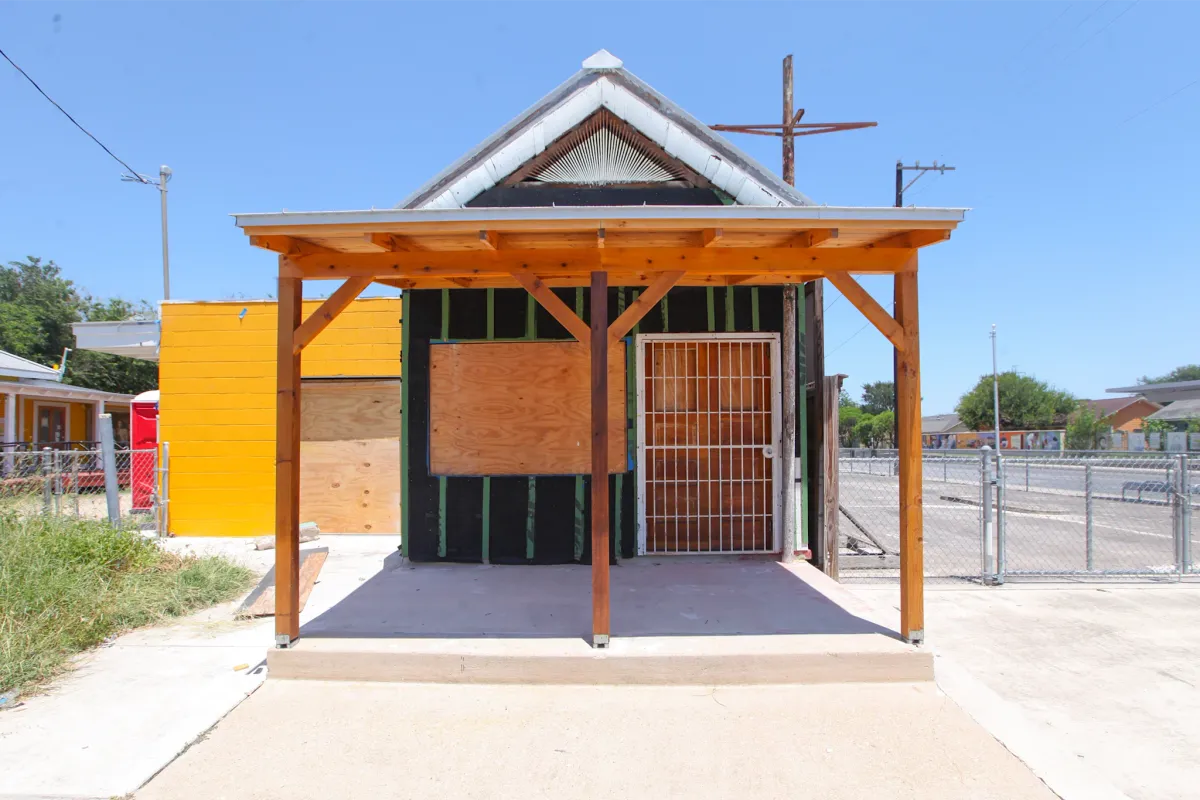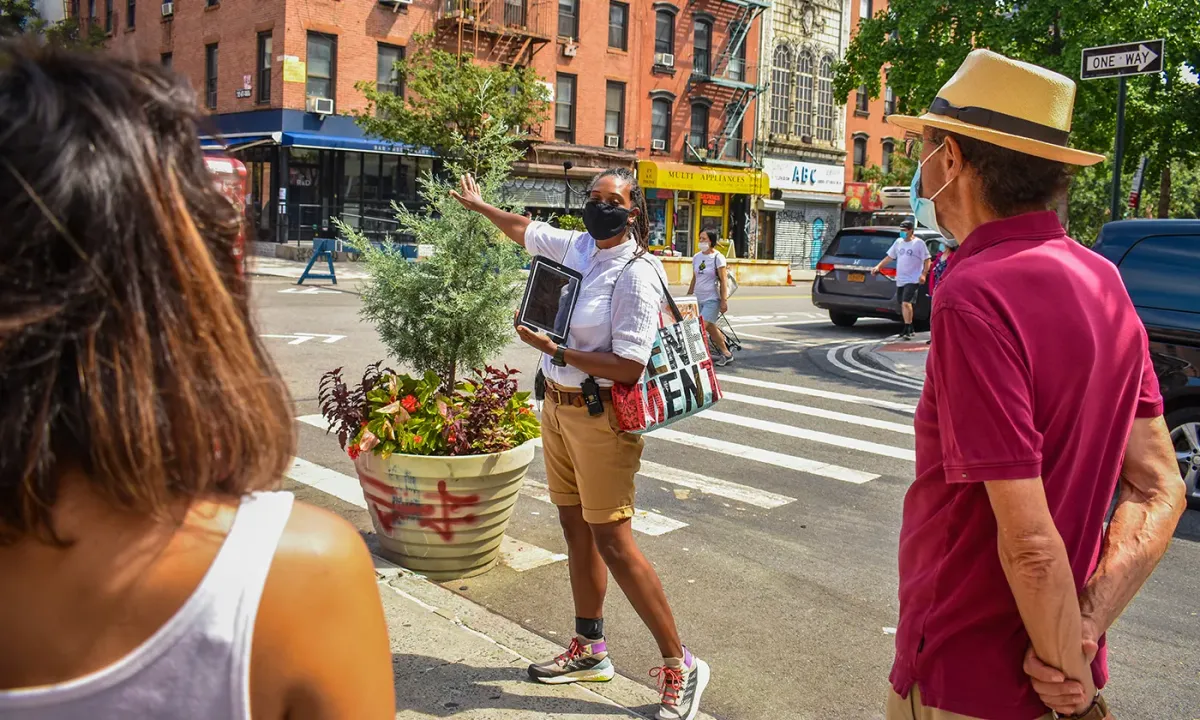A New Museum Honors San Antonio's Mexican American and Working-Class Communities
Museo del Westside, a new museum in San Antonio's Westside neighborhood, preserves the area’s vibrant cultural and architectural heritage.

The Westside neighborhood of San Antonio, Texas, is the heart of the city’s Mexican-American working-class communities. Today, murals and tile mosaics featuring themes from Latinx culture dot the area. A bright yellow and orange “Bienvenidos al Westside” sign welcomes visitors to the neighborhood’s central Guadalupe Street, which grew into a thriving cultural and commercial corridor a century ago as the neighborhood’s Mexican immigrant population boomed.
The rich histories and culture of San Antonio’s Westside are disappearing as urban renewal, gentrification, and profit-driven interests force out local families. While tourism allows the city of San Antonio to capitalize on the Mexican-American culture fostered in the Westside, harmful biases about the city’s working-class and Mexican-American communities persist and hinder preservation efforts in their neighborhoods.
“Because the Westside has, for most of its history, been mainly working class and mainly Mexican American, there’s been a kind of stigma,” said Laura Hernández-Ehrisman, an assistant professor at the University of Texas at Austin. Hernández-Ehrisman grew up in San Antonio and now serves as a research consultant for a new community-led museum, Museo del Westside.
I’m just getting started and offering a special discount for my early sign-ups. Click to subscribe and save $18 on your first six months:
“I grew up on the Westside. My mother, born in 1923, grew up in the Westside. Even when she was a child in the 1920s, ’30s, and ’40s, she said they always talked about the Westside as being the bad side of town,” explained Graciela Sánchez, the co-founder and director of San Antonio’s Esperanza Peace and Justice Center. As anti-immigrant narratives ramp up, especially leading into the election, Sánchez said kids from the area are growing up “hearing that they’re not good enough.”
The Museo del Westside disrupts this racist narrative by collecting, preserving, and uplifting the neighborhood’s heritage. “Part of the significance of Westsiders telling their own stories is to challenge those misconceptions,” Hernández-Ehrisman said.
The museum, which opened in October, is an initiative of the Esperanza Peace and Justice Center, a nonprofit organization founded in 1987 that has provided arts and culture programming to San Antonio’s Westside since the 1990s.
“There’s a lot of preservation going on. It shouldn’t just be, though, for middle- and upper-class communities and neighborhoods,” said Sánchez. For decades, preservation efforts across San Antonio have tended to focus on wealthier and whiter neighborhoods, elevating places such as the King William neighborhood to the status of a protected historic district. That neighborhood was named for King Wilhelm I, who ruled Prussia in the mid-19th century, when Germans began settling in the area. It became San Antonio’s first designated historic district in 1968. Meanwhile, Sánchez says residents on the Westside are watching their neighborhood “disappear little by little.”
The disappearance of cultural heritage from communities of color is a problem nationwide. While Latinx people are the largest racial or ethnic group in the nation behind white people, less than 1% of sites in the National Register of Historic Places are associated with Latinx histories. The U.S. Advisory Council on Historic Preservation created an Equity Action Plan in 2022, recognizing shortcomings in existing preservation structures and committing to building a more inclusive national preservation program. While federal systems work to become more inclusive, grassroots initiatives are already emerging to protect threatened heritage in areas like San Antonio’s Westside.
The Westside neighborhood is one of the most impoverished in the region. A multi-year analysis published in 2019 by the nonprofit Texas Appleseed found that those living in the Westside’s 78207 zip code have worse-than-average outcomes in employment, income, and education. About 40% percent of households in the zip code also live below the federal poverty line—more than three times the rate in Texas as a whole. The population in this area of San Antonio is more than 90% Hispanic or Latino.
Gentrification and displacement have hit the Westside hard. Reporting by The Texas Tribune in 2022 found that outside developers and land speculators were flooding residents with unsolicited offers to buy their homes. Houses are also being flipped at prices community members could never afford, and many longtime residents fear that an influx of wealthier newcomers will not only whitewash the neighborhood’s vibrant culture and architectural heritage, but also threaten the ability of the neighborhood’s poorest families to keep their homes.
“Developers and the business community are always on the lookout to make money, and they’ll always look for ways to try to demolish some of these buildings or change them to where there’s only a facade left or a memorial plaque on a new building, [and] that’s not sufficient to preserve the history,” said Ray Morales, a retired architect and member of the Historic Westside Residents Association.
A 2021 report from researchers at the University of Texas found that the city of San Antonio ordered the demolition of more single-family homes from 2015 to 2020 than any other large Texas city. According to the report, four of the five census tracts with the highest number of vacate and demolition orders during that period in San Antonio were on the Westside. Other historic Westside buildings, including commercial and industrial buildings in Cattleman Square, have also been put on the chopping block.
“Once a building goes down, it’s hard to really understand what was there and understand the stories that people tell,” Morales said.
The Esperanza Peace and Justice Center, the Historic Westside Residents Association, and the Westside Preservation Alliance are at the forefront of the battle to preserve the district’s architectural heritage. One of their victories is the building that will become the Museo del Westside, located on a corner of Guadalupe Street. The local landmark was once a home built in the 1930s. It later became a family-owned supermarket and then a community gathering spot called Ruben’s Ice House, named after the owner’s eldest son. The icehouse closed in the mid-’80s, but locals remember it fondly.
When the remaining family behind Ruben’s decided to sell the property in the mid-2000s, they opted to sell it to the Esperanza Center to honor their late mother’s devotion to the community—despite receiving another offer well above the asking price. The Esperanza Center took ownership of the building in 2007 with a loose vision for what would become the Museo del Westside.
It took more than a decade to secure funding to rehabilitate the old building and move the project forward. After receiving support from the Mellon Foundation, Impact San Antonio, and the city of San Antonio’s Westside Tax Increment Reinvestment Zone, the Esperanza Center finally broke ground on the museum in March 2022. Construction will renovate the icehouse and add a 1,000-square-foot earthen block gallery, resulting in a 2,300-square-foot museum.
When the museum opens later this year, it will anchor the Rinconcito de Esperanza, or “Little Corner of Hope,” to serve as a hub for the Esperanza Center’s cultural programming. This project began when the organization purchased a folk Victorian house called Casa de Cuentos and a 200-square-foot casita in its backyard, dating to the 1920s. The casita is the kind of home a typical working-class Westside family would have lived in a century ago. The Esperanza Center currently operates the larger home as a community gathering center. Since 2006, a series of historical black-and-white photographs showing past generations of Westside residents have hung on the property as part of the Esperanza Center’s Fotohistorias del Westside Street Museum. The MujerArtes Women’s Clay Cooperative studio, built using adobe bricks, is also located on the same block.
The community-led development process behind Museo del Westside has been “unlike any other,” according to Antonia Castañeda, a professor emeritus of history at St. Mary’s University and member of the Westside Preservation Alliance. “It is totally a community-based, community-developed museum.”
Hundreds of community members have contributed to what will become the museum during regular community gatherings, including museum development meetings, monthly convenings for elders, and events to collect local oral histories.
“That makes it complicated, sometimes difficult, but always exciting and thrilling to hear all these voices and the desire, the interests, the willingness to give their time, their energy, their knowledge, their intellect, their creativity to create this historical, cultural entity that honors and reveals the history and culture of these working-class communities,” said Castañeda.
Alongside community input, academic researchers help lead the research and exhibition development process. Hernández-Ehrisman is one of these academic consultants. She told Prism that her understanding of historical research and preservation as justice-seeking work guided her research and broadly informs decision-making around the museum’s exhibitions.
“Exploring and learning about the community in the past also informs how we engage in the present,” she said. “As we learn about various kinds of activism in the past, it can help inform us as we do this kind of work in the future.”
For Sánchez, too, the museum is part of the Esperanza Center’s decades-long work of cultural organizing that centers “the work and the ways of women and girls.” The museum’s first virtual exhibition, available online before the museum opens for in-person visitors in September, reflected this ethos. Titled “Women & Activism in the Westside,” the exhibition features portraits and histories of more than 30 women who worked in the neighborhood. The list includes Nickie Valdez, a lesbian Catholic woman who served as a bridge between the Catholic faith and LGBTQIA+ communities rejected by the Church, and midwife Romana Ramos, who in the early 20th century delivered thousands of babies in the Westside.
The museum’s first planned on-site exhibition, “Historias del Westside,” is an ambitious survey of Westside history from the 1880s into the 1970s that will feature artifacts “lovingly” donated by members of the community, Sánchez said. This includes hundreds of family photographs going as far back as the early 1900s; family heirloom metates, or mealing stones used for making corn tortillas; and even a sign that used to hang outside Ramos’ office, donated by a community member. The family behind Ruben’s Ice House has also remained involved in the museum’s development, and a permanent exhibition at the museum’s entrance will honor the history of the business and its importance to the community.
Visitors eager to interact with the museum’s on-site offerings got a first glimpse in early May during the Paseo por el Westside, an annual gathering and neighborhood walk celebrating the Westside’s culture, history, and “conviviencia,” or conviviality.
Castañeda says visitors’ feedback reflected an understanding of the need for grassroots preservation efforts. “We had a tremendous attendance,” she said. “People were deeply impressed and deeply appreciative and engaged and excited to see this museum develop.”
This story was originally published by Prism, an independent and nonprofit newsroom led by journalists of color that reports from the ground up and at the intersections of injustice.



